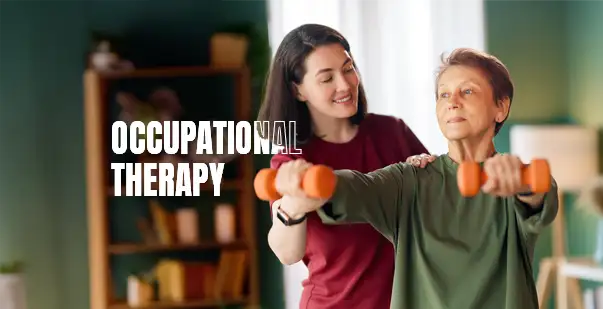A stroke doesn’t just affect the brain. After recovery, it disrupts daily life in countless ways. Simple tasks like buttoning a shirt or holding a fork suddenly feel impossible. That’s where occupational therapy (OT) for stroke steps in. It focuses on restoring independence by helping survivors relearn everyday skills. According to the Brain & Neurorehabilitation, nearly one in three stroke survivors in the U.S. face long-term disability. With the right therapy, many regain function that once seemed lost. Occupational therapists design hands-on, practical strategies that target movement, memory, and problem-solving. So, keep reading to explore how occupational therapy helps stroke patients regain independence. Not just physically, but emotionally and practically, one small step at a time.
Read More: What Is Pediatric Occupational Therapy?
Why Stroke Survivors Need Occupational Therapy
After a stroke, it can be hard to do simple daily tasks like eating, getting dressed, brushing your hair, cooking, or going back to work. That’s because a stroke can affect parts of your brain that control movement, coordination, and thinking. These challenges can make it tough to return to work unless you get the right kind of rehabilitation. Moreover, stroke recovery isn’t just about regaining motor control. Many people deal with memory issues, sensory changes, mood swings, or constant tiredness.
To deal with all these problems, you can reach out to an occupational therapist.
They will first identify areas of struggle and build a plan to improve specific skills and movements accordingly.
This plan will help you rebuild useful habits, adjust to changes, and feel more in control of your routine again. The goal is simple- to help you live more independently, in a way that works for you.
Read More: Who Is an Occupational Therapy Assistant
How Occupational Therapy Supports Physical Recovery
A major 2024 meta-analysis found that activity-based task-oriented training significantly improves upper-limb motor function and activities of daily living (ADLs) for stroke survivors. Let’s look at how OT helps your body recover by building back motor skills and using real-life activities to retrain movement:
Rebuilding Fine and Gross Motor Skills
After a stroke, many people deal with weakness, stiffness, or loss of control in their arms and hands. This affects both big movements, like reaching, and smaller ones, like buttoning a shirt. An occupational therapist works with you to improve both types of movement, step by step.
They may use:
Task-Specific Training: You practice exact actions you need in daily life, like holding a toothbrush or turning a key.
Constraint-Induced Movement Therapy (CIMT): Your dominant side is still re-learning, so the weaker side has to work more.
Mirror Therapy: Watching your dominant side move in a mirror helps your brain activate the weaker side.
Bilateral Arm Training: You train both arms together to improve coordination.
These methods help your brain form new pathways. That’s how you start to regain control of your movement over time.
Rebuilding Fine and Gross Motor Skills After a Stroke
Retraining the Body Through Functional Movement
Apart from specific exercises designed to retrain the brain, occupational therapy for stroke also uses everyday tasks that matter to you. For example, you might fold laundry, chop vegetables, or practice typing on a keyboard.
These activities help in two main ways:
They make you more independent, which builds your confidence.
They prepare you for daily challenges, both physically and mentally.
This kind of focused, task-based training is effective because it taps into how the brain naturally learns: by repeating actions that hold meaning to us. That’s why it works so well during stroke recovery.
Read More: Differences Between Occupational Therapy And Physical Therapy
Addressing Cognitive and Emotional Challenges After Stroke
Most people think of stroke recovery as physical, but many survivors also deal with changes in thinking, memory, and emotions. These issues can affect how you manage daily life, even when you start to feel in control again. OTs are trained to help you work through these challenges using proven methods.
Cognitive Challenges After Stroke
After a stroke, it’s common to have trouble with focus, short-term memory, or solving problems. You might struggle to follow a recipe, pay bills, or remember appointments.
Occupational therapists help you rebuild these skills. They might suggest using tools like checklists or phone reminders. They’ll also work with you to set up routines that make your day more predictable. And they’ll give you brain exercises that start easy and slowly get harder, so your thinking improves over time.
Handling Emotions After a Stroke
Feeling sad, anxious, or frustrated after a stroke is normal, but that doesn’t mean you have to deal with it alone. These emotional changes often happen because of how the brain has been affected.
Occupational therapists support you with practical tools to manage stress, calm your mind, and stay focused during tough moments. If you’ve lost a job or can’t take care of your family the way you used to, they’ll help you find new roles and routines that feel meaningful. These steady changes help you feel more confident and in control again.
Modifying the Environment for Safety and Independence
If you’re caring for an older adult, making the environment safer can go a long way. Even small changes in the home or workplace can lower the risk of falls, make movement easier, and help them feel more in control of their daily tasks.
Start with the basics. Add grab bars in bathrooms, remove loose rugs or cords that might cause someone to trip, and make sure every room has enough lighting. You can also rearrange kitchen items so there’s less need to bend or stretch.
You can also try using assistive tools. Things like reachers, button hooks, shower chairs, walkers, and built-up utensils help older adults do things more independently. These tools don’t just make tasks easier; they give them more independence and help them get back to their normal routine after being sick or injured.
Goal-Setting and Family Support in Occupational Therapy
Occupational therapy is all about returning you to your daily routine with as much independence as possible. To accomplish that, therapists create practical goals with you, monitor your progress, and engage your family in a manner that enhances your recovery. Here's the process:
Set measurable goals: Instead of vague targets like "improve mobility," your therapist helps you set specific goals like "make my own tea" or "walk to the bus stop."
The recovery plan is designed for you: Therapists consider your physical ability, daily routine, and home setup. They break big goals into smaller steps so you can track progress clearly.
Progress is measured and adjusted: Tools and regular check-ins help you and your therapist see what’s working and where to adjust.
Family helps without overstepping: Caregivers are guided to support your efforts, like holding fabric while you button your shirt, instead of doing tasks for you.
Read More: What You'll Learn in a Physical Therapy Course for Healthcare Providers?
Occupational Therapy for Stroke and Everyday Living!
Occupational therapy for stroke helps survivors regain control over daily life. It focuses on improving movement, thinking skills, emotional strength, and home or work routines. Therapists create recovery plans that match each person’s needs and goals.
This kind of support helps you get back to everyday tasks like getting dressed, cooking, or managing your schedule. It also builds confidence by setting clear goals and involving your family in the process.
If you or someone close to you is recovering from a stroke, reach out to an organization that offers occupational therapy. A trained therapist can guide you step by step toward greater independence.
FAQs
What does occupational therapy do after a stroke?
Occupational therapy helps stroke survivors get back to everyday life. Therapists work on skills like eating, dressing, or bathing, which also improve strength and coordination. The aim is to make daily tasks easier and build confidence during recovery.
How can occupational therapy improve movement?
Therapists guide patients through exercises that strengthen weak muscles and improve coordination. They also teach new ways to complete tasks when movement is limited. With time and practice, this helps people regain better control of their arms and hands.
Does occupational therapy help with memory issues?
Yes. Many stroke survivors face memory or concentration problems. Therapists use reminders, routines, and problem-solving activities to strengthen thinking skills. These strategies make daily life safer and easier, from remembering appointments to managing household tasks.
When should occupational therapy start after a stroke?
Therapy usually begins once the patient is stable, often within the first few days. Starting early is important because the brain heals and adapts best during this stage, which can make recovery more effective.
What tools are used in occupational therapy for stroke recovery?
Therapists often suggest simple aids like special utensils, grab bars, or dressing tools. Along with these, they design exercises that build strength and focus. Together, these tools make daily routines more manageable and support long-term independence.
References:





